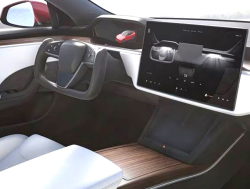
—
A Tesla wrongful death lawsuit alleges David W. Dryerman, 54, Michele D. Dryerman 54, and Brooke H. Dryerman, 17, were killed by a defective 2024 Tesla Model S.
On September 14, 2024, David Dryerman was driving the 2024 Tesla Model S north on Garden State Parkway in Woodbridge Township, New Jersey. His wife Michele was in the front passenger seat and their daughter Brooke was in the left back seat.
The lawsuit says all three were wearing their seat belts when the Model S “was caused to leave its lane of travel, traverse a segment of the adjacent grassy shoulder and collide with a concrete bridge support.” All three occupants were killed.
The Tesla lawsuit, filed by their son Max, alleges the three were killed because of defects in the design of the Tesla Model S, including the occupant restraint systems.
According to the wrongful death lawsuit:
“The movement of the Tesla S occurred—according to the Tesla EDR records—as the ‘Accelerator Pedal (%)’ went from 0.0 (with a speed of 63 mph) to 100.0 without any significant change in vehicle speed and without any reported ‘Service Brake’ recording.”
The wrongful death lawsuit claims the Tesla Model S was not crashworthy, and the automaker supposedly failed to warn Mr. Dryerman of the limitations of the driver assistance systems.
“Tesla’s failure to produce the subject Model S with the ability to absorb reasonable collision forces and with adequate occupant protection systems is inexplicable, negligent, reckless, and rendered the vehicle not crashworthy and unreasonably dangerous and defective.” — Dryerman Tesla lawsuit
The Tesla Model S allegedly failed to detect it was traveling off the road and did not automatically steer the car back into the driving lane. There was also no warning the car was getting ready to slam into the bridge support, and the brakes allegedly failed to automatically stop the vehicle before crashing into the concrete bridge support.
The lawsuit alleges multiple components of the 2024 Tesla Model S were defective and Mr. Dryerman was not warned of the problems when he purchased the car.
A large focus of the lawsuit is placed on the advanced driver assistance systems “Autopilot,” “Enhanced Autopilot,” “Full Self-Driving Capability,” and/or “Full Self-Driving Supervised.”
The plaintiffs complain thousands of Tesla drivers rely on the ADAS technology and believe it is capable of “fully autonomous self-driving with minor software updates….”
However, Tesla says its driver assistance features require drivers to stay attentive and keep their hands on the steering wheels, ready to take full control at any time. Several warnings in the owner’s manual emphasize Autopilot and other systems do not make the cars autonomous, which is why the systems are called driver “assistance” systems.
But the 2024 Tesla Model S was allegedly defective because it accelerated without the intent or control of David Dryerman.
According to the wrongful death lawsuit, the Tesla Model S was “not safe for its intended and foreseeable uses” because these features and systems were defective:
- Forward Collision Warning
- Lane Departure Avoidance
- Emergency Lane Departure
- Autosteer
- Obstacle Aware Acceleration
- Acceleration and/or Pedal Misapplication Mitigation
- Side Collision Warning
- Automatic Emergency Braking
The Dryerman Tesla Model S crash lawsuit was filed in the U.S. District Court for the District of New Jersey (Camden Vicinage): Max Dryerman, et al., v Tesla, Inc.
The plaintiffs are represented by Anapol Weiss.

